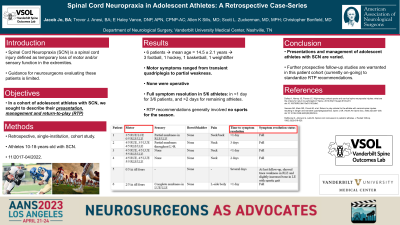Transient quadriparesis in adolescent athletes: a retrospective case-series
Transient Quadriparesis in Adolescent Athletes: A Retrospective Case-series
Friday, April 21, 2023


Jacob Jo, BA (he/him/his)
Medical Student
Vanderbilt University School of Medicine
ePoster Presenter(s)
Introduction: While transient quadriparesis (TQ) is a well-documented pathology that affects athletes, guidance for neurosurgeons evaluating these patients is sparse. In a cohort of athletes with TQ, we sought to: 1) review the presentation/treatment and 2) discuss outcomes/return-to-play (RTP).
Methods: A retrospective, case-series was performed to identify patients diagnosed with TQ from 2017-22. TQ was defined as an episode of bilateral upper/lower extremity weakness after a collision during sport. Collected variables included demographics/description of event/symptoms/management/outcomes/RTP.
Results: Six patients met inclusion criteria. The average age was 14.5±2.1 and all were male who played sports at a middle/high-school level. Three football players sustained tackle injuries, one hockey and another basketball player fell/landed on his head/neck, and one weightlifter sustained an axial load of 175lbs to his neck. Motor/sensory symptoms ranged from quadriplegia to transient weakness/numbness. None had bowel/bladder symptoms. All endorsed neck pain. Full symptom resolution was seen in all athletes: in < 1 day for 3/6 patients, and for the remaining athletes on days 2, 3, and 4. 4/6 patients had a full trauma work-up, were admitted (hospitalization:1-5d), and were placed in a c-collar. 4/6 patients had negative imaging, while 2 had incidental findings of R-paracentral disc protrusion at T9-T10 and mild L-facet arthropathy at L4-L5/L5-S1. None had congenital stenosis. On axial cervical MRI, mean space for the cord was 10.5±1.1mm. 5/6 patients were treated with bed rest/c-collar, except 1/6 who received IV dexamethasone. RTP recommendations involved being told not play for the season. One patient returned to full-contact football at 3-months, and the other to moderate basketball playing at 1-month.
Conclusion : Presentations of adolescent athletes with TQ are varied, making it difficult to standardize management. RTP appears possible after a period of rehabilitation. Further prospective follow-up studies are warranted in this patient cohort in an effort to standardize RTP recommendations.
Methods: A retrospective, case-series was performed to identify patients diagnosed with TQ from 2017-22. TQ was defined as an episode of bilateral upper/lower extremity weakness after a collision during sport. Collected variables included demographics/description of event/symptoms/management/outcomes/RTP.
Results: Six patients met inclusion criteria. The average age was 14.5±2.1 and all were male who played sports at a middle/high-school level. Three football players sustained tackle injuries, one hockey and another basketball player fell/landed on his head/neck, and one weightlifter sustained an axial load of 175lbs to his neck. Motor/sensory symptoms ranged from quadriplegia to transient weakness/numbness. None had bowel/bladder symptoms. All endorsed neck pain. Full symptom resolution was seen in all athletes: in < 1 day for 3/6 patients, and for the remaining athletes on days 2, 3, and 4. 4/6 patients had a full trauma work-up, were admitted (hospitalization:1-5d), and were placed in a c-collar. 4/6 patients had negative imaging, while 2 had incidental findings of R-paracentral disc protrusion at T9-T10 and mild L-facet arthropathy at L4-L5/L5-S1. None had congenital stenosis. On axial cervical MRI, mean space for the cord was 10.5±1.1mm. 5/6 patients were treated with bed rest/c-collar, except 1/6 who received IV dexamethasone. RTP recommendations involved being told not play for the season. One patient returned to full-contact football at 3-months, and the other to moderate basketball playing at 1-month.
Conclusion : Presentations of adolescent athletes with TQ are varied, making it difficult to standardize management. RTP appears possible after a period of rehabilitation. Further prospective follow-up studies are warranted in this patient cohort in an effort to standardize RTP recommendations.
